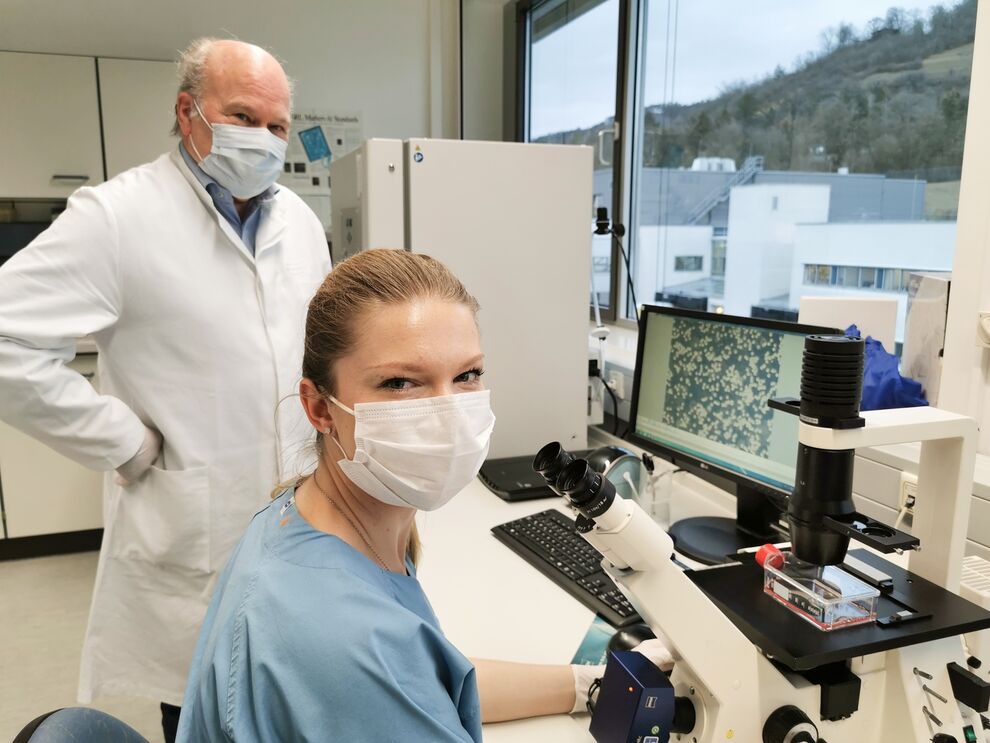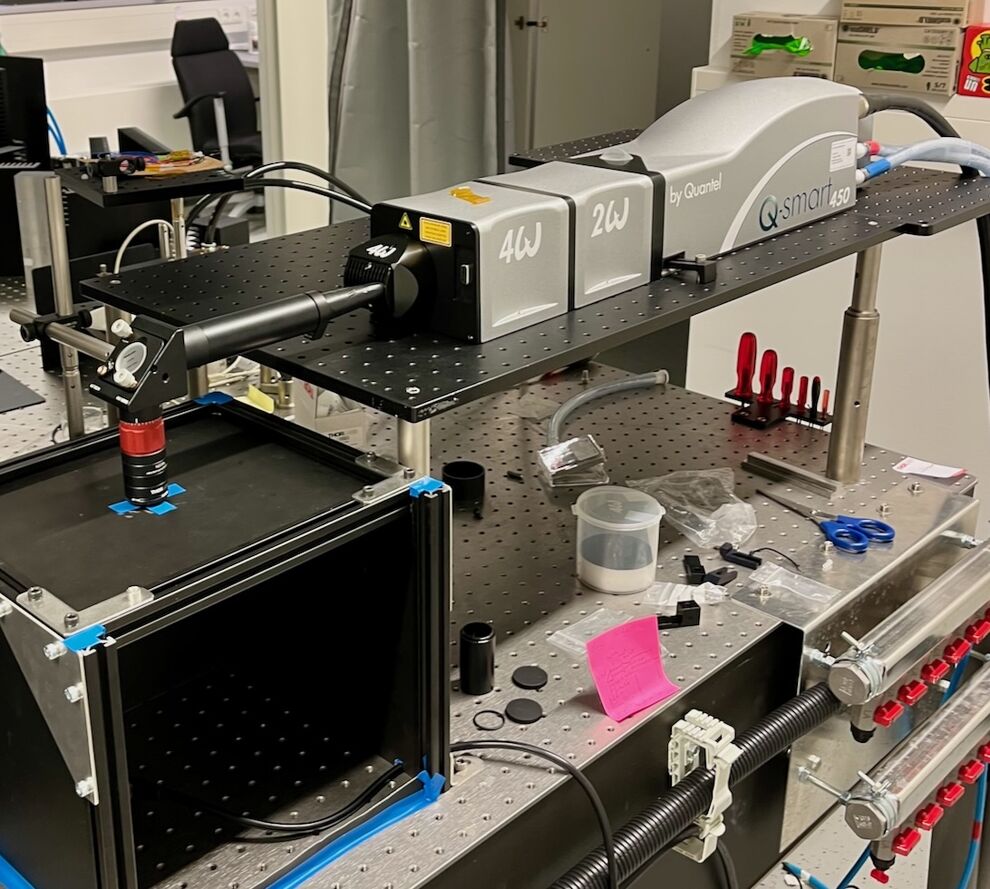Research Focus
The entire nature of tumor cells and their communication with the microenvironment is complex. We are interested in the mechanism, which drive the dissemination of tumor cells from the primary tumor and allow the survival of these cells in the circulation and finally their evasion. An import role in these processes plays the bone morphogenetic protein signaling network. In collaboration with partners from academia and industry we develop new procedures to identify and isolate the entirety of circulating tumor cells from the peripheral blood. Novel photonic technologies and innovative nanomaterials contribute to a significant part to this approach.
Innovative nanomaterials in hematology and oncology
Magnetic metallic nanoparticles are widely used tools to isolate and label cells, e.g. circulating tumor cells. We are interested in understanding the cellular processes during the interaction of nanomaterials with human cells. In focus are overall cell vitality, intracellular transport mechanisms and inflammatory response. The life cycle of nanomaterials is studied in long-term cell culture models.
Identification and characterization of circulating tumor cells
The detection and identification of circulating tumor cells is challenging. The proportion of these cells is very low in the peripheral blood of tumor patients. The cell population is highly variable which requires an in-depth investigation on a single cell level. A further characterization on the molecular level is needed for future advances in cancer diagnosis and therapy.
Tumor biology of Bone Morphogenetic Proteins
Bone morphogenetic proteins are a subgroup of the Transforming Growth Factor beta superfamily. They are important regulators of embryogenesis, organogenesis and tumorigenesis. We could show that BMP-2 keeps cells in a “susceptible state” that can take various directions depending on further signals.
Publications (Selection)
2024
Ma, Y., Nenkov, M., Berndt, A., Abubrig, M., Schmidt, M., Sandhaus, T., Huber, O., Clement, J.H., Lang, S.M., Chen, Y. und Gaßler, N. 2024. The diagnostic value of ACSL1, ACSL4 and ACSL5 and the clinical application of ACSL inhibitor in non-small cell lung cancer. Cancers 16: 1170
2023
Mickoleit, F., Jörke, C., Richter, R., Rosenfeldt, S., Markert, S., Rehberg, I., Schenk, A.S., Bäumchen, O., Schüler, D., Clement J.H. 2023. Long-term stability, biocompatibility and magnetization of suspensions of isolated bacterial magnetosomes. Small: DOI: 10.1002/smll.202206244
Wurschi, G.W., Güllmar, D., Gaßler, N., Clement J.H., Kesselmeier, M., Müller-Wurschi, J.J., Settmacher, U., Mothes, H., Helfritzsch, H., Liebe, Y., Franiel, T., Mäurer, M.A., Ernst, T., Nicolay, N.H., Wittig, A. 2023. Planning adaptive treatment by longitudinal response assessment implementing MR imaging, liquid biopsy and analysis of microenvironment during neoadjuvant treatment of rectal cancer (PRIMO). Medicine 102(17): e33575
2022
Ernst, P., Schnöder, T.M., Huber, N., Perner, F., Jayavelu A.K., Eifert, T., Hsu C.-J., Santamaria, N.T., Crodel, C., Ungelenk, M., Hübner, C.A., Clement, J.H., Hochhaus, A., Heidel, F.H. 2022. Histone demethylase KDM4C is a functional dependency in JAK2-mutated neoplasms. Leukemia 36: 1843-1849
Dutz, S., Weidner, A., von der Lühe, M., Gräfe, C., Biehl, P., Demut, J., Warncke, P., Jungmann, S., Fischer, D., Schacher, F.H., Clement, J.H. 2022. Hybrid Nanomaterials of Biomolecule Corona Coated Magnetic Nanoparticles and Their Interaction with Biological Systems. Physical Sciences Reviews 7: 1311-1344; https://doi.org/10.1515/psr-2019-0110
Gräfe, C., Müller, E., Gresing, L., Weidner, A., Radon, P., Friedrich, R., Alexiou, C., Wiekhorst, F., Dutz, S. und Clement, J.H. 2022. Magnetic hybrid materials interact with biological matrices – Interaction of magnetic nanoparticles with cellular barriers. Physical Sciences Reviews 7: 1443-1500; https://doi.org/10.1515/psr-2019-0114
2021
Daum, A.K., Dittmann, J., Jansen, L., Peters, S., Dahmen, U., Heger, J., Hoppe-Seyler, F., Gille.A., Clement, J.H., Runnebaum, I.B., Dürst, M., Backsch, C. 2021. ITIH5 shows tumor suppressive properties in cervical cancer cells grown as multicellular tumor spheroids. American Journal of Translational Research 13: 10298-10314. eCollection 2021.
Mickoleit, F., Jörke, C., Geimer, S., Maier, D., Müller, J.P., Demut, J., Gräfe, C., Schüler, D., Clement, J.H. 2021. Biocompatibility, uptake and subcellular localization of bacterial magnetosomes in mammalian cells. Nanoscale Advances 3: 3799-3815; https://doi.org/10.1039/D0NA01086C
Gericke, M., Geitel, K., Jörke, C., Clement, J.H., Heinze, T. 2021. Reactive nanoparticles derived from polysaccharide phenyl carbonates. Molecules 26: 4026; https://doi.org/10.3390/molecules26134026
Gresing, L.J., Radon, P., Friedrich, R.P., Zahn, D., Raasch, M., Mosig, A.S., Dutz, S., Alexiou, C., Wiekhorst, F., Hochhaus, A., Clement, J.H. 2021. Negatively charged magnetic nanoparticles pass the blood-placenta barrier under continuous flow conditions in a time-dependent manner. Journal of Magnetism and Magnetic Materials 521: 167535; doi.org/10.1016/j.jmmm.2020.167535
Rosenfeldt, S., Mickoleit, F., Jörke, C., Clement, J.H., Markert, S., Jérôme, V., Schwarzinger, S., Freitag, R., Schüler, D., Uebe, R., Schenk, A.S. 2021. Towards standardized purification and regeneration of bacterial magnetic nanoparticles for future in vivo applications. Acta Biomaterialia 120: 293-303
2020
Ernst, P., Press, A.T., Fischer, M., Schäfer, V., Gräfe, C., Clement, J.H., Ernst, T., Schubert, U.S., Bauer, M., Hochhaus, A. 2020. Polymethine dye-functionalized nanoparticles as a specific drug delivery system for the eradication of CML stem cells. Molecular Therapy – Oncolytics 18: 372-381
Dutz, S., Buske, N., Landers, J., Gräfe, C., Wende, H., Clement, J.H. 2020. Biocompatible magnetic fluids of Co-doped iron oxide nanoparticles with tunable magnetic properties. Nanomaterials: 10: 1019; doi.org/10.3390/nano10061019
2019
Mihajlović, J., Diehl, L.M.A., Hochhaus, A., Clement J.H. 2019. Inhibition of bone morphogenetic protein signaling reduces viability, growth and migratory potential of non-small cell lung carcinoma cells. J. Cancer Res. Clin. Oncol. 145: 2675-2687.
Alcala, N., Leblay, N., Gabriel, A., Mangiante, L., Hervas Marin, D., Giffon, T., Sertier, A.S., Ferrari, a., Derks, J., Ghantous, A., Delhomme, T.M., Chabrier, A., Cuenin, C., Abedi-Ardekani, B., Boland, A., Caux, C., Altmueller, A., Durand, G., Voegele, C., Boyault, S., Lemaitre, N., Lorimier, P., Toffart, A.C., Mc Leer, A., Solterman, A., Clement, J.H., Saenger, J., Field, J.K., Brevet, M., Blanc-Fournier, C., Galateau-Salle, F., Le Stang, N., Damiola, F., Russell, P., Wright, G., Roz, L., Lacomme, S., Vignaug, J.M., Hofman, V., Hofman, P., Brustugun, O.T., Lund-Iversen, M., Thomas de Montpreville, V., Muscarella, L.A., Graziano, P., Volante, M., Papotti, M.G., Brcic, L., Popper, H., Deleuze, J.F., Herceg, Z., Viari, A., Nuernberg, P., McKay, J.D., Sandoval, J., Hernandez-Vargas, H., Brambilla, E., Speel, E.J., Girard, N., Lantuejoul, S., Foll, M., Fernandez-Cuesta, L. 2019. Integrative and comparative analyses of multi-omics data identify clinically relevant molecular groups of pulmonary carcinoids and unveil the existence of supra-atypical carcinoids. Nature Commun. 10: 3407; doi.org/10.1038/s41467-019-11276-9
Gräfe, C., von der Lühe, M., Weidner, A., Globig, P., Clement, J.H., Dutz, S., Schacher, F.H. 2019. Protein Corona Formation and its Constitutional Changes on Magnetic Nanoparticles in Serum featuring a Polydehydroalanine Coating: Effects of Charge and Incubation Conditions. Nanotechnology 30(26):265707. doi: 10.1088/1361-6528/ab0ed0
Other publications here
Funding
Deutsche Forschungsgemeinschaft
BMBF
Dr. Rainald Stromeyer-Stiftung






